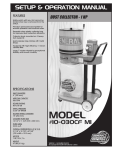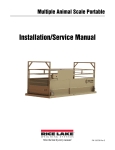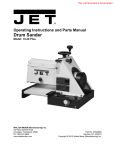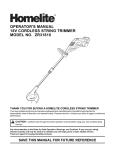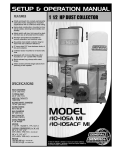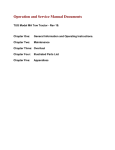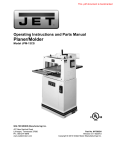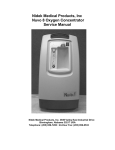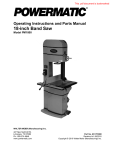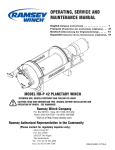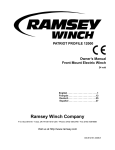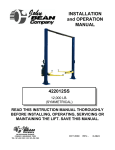Download General International 15-010 M1 Use and Care Manual
Transcript
SETUP & OPERATION MANUAL FEATURES 6" X 108" VERTICAL EDGE BELT SANDER Tables can be adjusted up or down for full belt use. Front table can be inclined left or right. Innovative hinged dust hood accommodates oversized stock. Easy adjustment of abrasive belt tension with one knob only. Graphite backing reduces belt friction for longer belt life. Single knob tracking control. Auxiliary table allows curved sanding. Heavy steel base ensures a solid stable platform while sanding. Dynamically balanced 7’’ rubber drive roller and crowned 3’’ idler roller to ensure solid belt tracking. Magnetic 2-step safety switch to prevent unwanted or unintentional start-up is equipped with an extra-large easy access stop panel and a lock-out key to prevent unauthorized use of the sander. SPECIFICATIONS BELT SIZE 6" X 108" (152 x 2743 MM) FRONT TABLE SIZE (L X W) 7 3⁄4” x 37’’ (197 x 940 MM) AUXILIARY TABLE SIZE (L X W) 11 3⁄4” x 19’’ (299 x 483 MM) DUST CHUTE OUTLET 4" (102 MM) BELT SPEED 3150 FPM BASE DIMENSIONS (L X W) 42” x 16 1⁄2” (1067 x 419 MM) MOTOR M1 2 HP, 220 V, 1 PH, 14 A M2 2 HP, 220 V, 3 PH, 6 A M3 2 HP, 600 V, 3 PH, 2.5 A WEIGHT 462 LBS (210 KG) MODEL #15-010 M1 VERSION 2_REVISION 1 - JUNE 08/10 (19115210) © Copyright General® International 06/2010 GENERAL® INTERNATIONAL 8360 Champ-d’Eau, Montreal (Quebec) Canada H1P 1Y3 Telephone (514) 326-1161 • Fax (514) 326-5555 • www.general.ca THANK YOU for choosing this General® International model 15-010 6" X 108" Vertical Edge Belt Sander. This sander has been carefully tested and inspected before shipment and if properly used and maintained, will provide you with years of reliable service. To ensure optimum performance and trouble-free operation, and to get the most from your investment, please take the time to read this manual before assembling, installing and operating the unit. The manual’s purpose is to familiarize you with the safe operation, basic function, and features of this sander as well as the set-up, maintenance and identification of its parts and components. This manual is not intended as a substitute for formal woodworking instruction, nor to offer the user instruction in the craft of woodworking. If you are not sure about the safety of performing a certain operation or procedure, do not proceed until you can confirm, from knowledgeable and qualified sources, that it is safe to do so. Once you’ve read through these instructions, keep this manual handy for future reference. Disclaimer: The information and specifications in this manual pertain to the unit as it was supplied from the factory at the time of printing. Because we are committed to making constant improvements, General® International reserves the right to make changes to components, parts or features of this unit as deemed necessary, without prior notice and without obligation to install any such changes on previously delivered units. Reasonable care is taken at the factory to ensure that the specifications and information in this manual corres- ponds with that of the unit with which it was supplied. However, special orders and “after factory” modifications may render some or all information in this manual inapplicable to your machine. Further, as several generations of this model of sander and several versions of this manual may be in circulation, if you own an earlier or later version of this unit, this manual may not depict your machine exactly. If you have any doubts or questions contact your retailer or our support line with the model and serial number of your unit for clarification. GENERAL® & GENERAL® INTERNATIONAL WARRANTY All component parts of General®, General® International and Excalibur by General International ® products are carefully inspected during all stages of production and each unit is thoroughly inspected upon completion of assembly. Limited Lifetime Warranty Because of our commitment to quality and customer satisfaction, General® and General® International agree to repair or replace any part or component which upon examination, proves to be defective in either workmanship or material to the original purchaser for the life of the tool. However, the Limited Lifetime Warranty does not cover any product used for professionnal or commercial production purposes nor for industrial or educational applications. Such cases are covered by our Standard 2-year Limited Warranty only. The Limited Lifetime Warranty is also subject to the “Conditions and Exceptions” as listed below. Standard 2-Year Limited Warranty All products not covered by our lifetime warranty including products used in commercial, industrial and educational applications are warranted for a period of 2 years (24 months) from the date of purchase. General® and General® International agree to repair or replace any part or component which upon examination, proves to be defective in either workmanship or material to the original purchaser during this 2-year warranty period, subject to the “conditions and exceptions” as listed below. To file a Claim To file a claim under our Standard 2-year Limited Warranty or under our Limited Lifetime Warranty, all defective parts, components or machinery must be returned freight or postage prepaid to General® International, or to a nearby distributor, repair center or other location designated by General® International. For further details call our service department at 1-888949-1161 or your local distributor for assistance when filing your claim. Along with the return of the product being claimed for warranty, a copy of the original proof of purchase and a “letter of claim” must be included (a warranty claim form can also be used and can be obtained, upon request, from General® International or an authorized distributor) clearly stating the model and serial number of the unit (if applicable) and including an explanation of the complaint or presumed defect in material or workmanship. CONDITIONS AND EXCEPTIONS: This coverage is extended to the original purchaser only. Prior warranty registration is not required but documented proof of purchase i.e. a copy of original sales invoice or receipt showing the date and location of the purchase as well as the purchase price paid, must be provided at the time of claim. Warranty does not include failures, breakage or defects deemed after inspection by General® or General® International to have been directly or indirectly caused by or resulting from: improper use, or lack of or improper maintenance, misuse or abuse, negligence, accidents, damage in handling or transport, or normal wear and tear of any generally considered consumable parts or components. Repairs made without the written consent of General® Internationallwill void all warranty. TABLE OF CONTENTS SAFETY RULES . . . . . . . . . . . . . . . . . . . . . . .5 MAINTENANCE . . . . . . . . . . . . . . . . . . . . . .14 Periodic maintenance . . . . . . . . . . . . . . . . .14 ELECTRICAL REQUIREMENTS . . . . . . . . . . . . . .6 Required maintenance . . . . . . . . . . . . . . . .14 Electrical connections . . . . . . . . . . . . . . . . . . . . . . .6 Grounding instructions . . . . . . . . . . . . . . . . . . . . . . .6 Circuit capacity . . . . . . . . . . . . . . . . . . . . . . . . . . . . .6 Check power connection for polarity . . . . . . . . . .6 Extension cords . . . . . . . . . . . . . . . . . . . . . . . . . . . . .6 Replacement of the sanding belt . . . . . . . . . . . . .14 Replacement of the graphite coating on the platen . . . . . . . . . . . . . . . . . . . . . . . . . . . . . . . . . . . .15 Steel platen adjustment . . . . . . . . . . . . . . . . . . . . .16 Spring fatigue compensation adjustment . . . . . .16 Lubrication . . . . . . . . . . . . . . . . . . . . . . . .16 IDENTIFICATION OF MAIN PARTS AND COMPONENTS . . . . . . . . . . . . . . . . . . . . . . . . . . . .7 RECOMMENDED OPTIONAL ACCESSORIES . . . .17 BASIC FUNCTIONS . . . . . . . . . . . . . . . . . . . .8 PARTS LIST AND DIAGRAMS . . . . . . . . . . . . .18 UNPACKING . . . . . . . . . . . . . . . . . . . . . . . .8 CONTACT INFORMATION . . . . . . . . . . . . . . . .22 List of contents . . . . . . . . . . . . . . . . . . . . . . . . . . . . . .8 PLACEMENT WITHIN THE SHOP / ESTABLISHING A SAFETY ZONE . . . . . . . . . . . . . . . . . . . . . . .9 LIFTING AND HANDLING THE MACHINE . . . . . . .9 ASSEMBLY INSTRUCTIONS . . . . . . . . . . . . . .10 Reposition the auxiliary table mounting bracket .10 Install the tables . . . . . . . . . . . . . . . . . . . . . . . . . . . .10 Install the dust hood/end guard . . . . . . . . . . . . . .11 Connecting to a dust collector . . . . . . . . . . . . . . .11 BASIC ADJUSTMENTS & CONTROLS . . . . . . . .11 Connecting to a power source . . . . . . . . . . . . . . .11 Magnetic safety switch . . . . . . . . . . . . . . . . . . . . . .12 Overload protection/Circuit breaker . . . . . . . . . .12 Front table height adjustment . . . . . . . . . . . . . . . .12 Front table inclination adjustment . . . . . . . . . . . .13 Auxiliary table height adjustment . . . . . . . . . . . . .13 Sanding belt tracking adjustment . . . . . . . . . . . . .13 RULES FOR SAFE OPERATION To help ensure safe operation, please take a moment to learn the machine’s applications and limitations, as well as potential hazards. General® International disclaims any real or implied warranty and holds itself harmless for any injury that may result from improper use of its equipment. 1. Do not operate the sander when tired, distracted, or under the effects of drugs, alcohol or any medication that impairs reflexes or alertness. 2. The working area should be well lit, clean and free of debris. 3. Keep children and visitors at a safe distance when the sander is in operation; do not permit them to operate the sander. 4. Childproof and tamper proof your shop and all machinery with locks, master electrical switches and switch keys, to prevent unauthorized or unsupervised use. 5. Stay alert! Give your work your undivided attention. Even a momentary distraction can lead to serious injury. 6. Fine particulate dust is a carcinogen that can be hazardous to health. Work in a well-ventilated area and wear eye, ear and respiratory protection devices. 7. Do not operate this sander without an adequate dust collection system properly installed and running. Operating this sander without adequate dust collection can lead to equipment malfunction or dangerous situations for the operator or other individuals in the workshop. 8. Do not wear loose clothing, gloves, bracelets, necklaces or other jewelry while the sander is in operation. Wear protective hair covering to contain long hair and wear non-slip footwear. 9. Be sure that adjusting wrenches, tools, drinks and other clutter are removed from the machine and/or the feed table surface before operating. 10. Keep hands well away from the sanding belts and all moving parts. Use a brush, not hands, to clear away sanding dust. 11. Be sure sanding belts are securely installed on the sanding drums. 13. Do not push or force the workpiece into the sander. The machine will perform better and more safely when working at the feed rate for which it was designed. 14. Avoid working from awkward or off balance positions. Do not overreach and keep both feet on floor. 15. To minimize risk of injury in the event of workpiece kickback, never stand directly in-line with the sanding belt or in the potential kickback path of the work piece. 16. Keep guards in place and in working order. If a guard must be removed for maintenance or cleaning, be sure it is properly re-attached before using the tool again. 17. Never leave the machine unattended while it is running or with the power on. 18. Use of parts and accessories NOT recommended by GENERAL® INTERNATIONAL may result in equipment malfunction or risk of injury. 19. Never stand on the machine. Serious injury could occur if the sander is tipped over or if the sanding belt is unintentionally contacted. 20. Always disconnect the tool from the power source before servicing, changing accessories or sanding belts, or before performing any maintenance or cleaning, or if the machine will be left unattended. 21. Make sure that switch is in “OFF” position before plugging in the power cord. 22. Make sure the tool is properly grounded. If equipped with a 3-prong plug it should be used with a three-pole receptacle. Never remove the third prong. 23. Do not use the sander for other than its intended use. If used for other purposes, GENERAL® INTER NATIONAL disclaims any real implied warranty and holds itself harmless for any injury, which may result from that use. 12. Do not operate the sander if the sanding belts are damaged or badly worn. 5 ELECTRICAL REQUIREMENTS BEFORE CONNECTING THE MACHINE TO THE POWER SOURCE, VERIFY THAT THE VOLTAGE OF YOUR POWER SUPPLY CORRESPONDS WITH THE VOLTAGE SPECIFIED ON THE MOTOR I.D. NAMEPLATE. A POWER SOURCE WITH GREATER VOLTAGE THAN NEEDED CAN RESULT IN SERIOUS INJURY TO THE USER AS WELL AS DAMAGE TO THE MACHINE. IF IN DOUBT, CONTACT A QUALIFIED ELECTRICIAN BEFORE CONNECTING TO THE POWER SOURCE. THIS TOOL IS FOR INDOOR USE ONLY. DO NOT EXPOSE TO RAIN OR USE IN WET OR DAMP LOCATIONS. NOTE: VOLTAGE REQUIREMENTS AND AMPERAGE DRAW FOR M2 & M3 3-PHASE MOTORS MAY NOT BE FULLY DESCRIBED IN THIS MANUAL. FOR COMPLETE ELECTRICAL REQUIREMENTS REFER TO THE MOTOR I.D. NAME PLATE ON THE MACHINE. IF IN DOUBT CONSULT A LICENSED QUALIFIED ELECTRICIAN BEFORE PROCEEDING. CHECK POWER CONNECTION FOR POLARITY After the wires have been connected it is necessary to check if they are connected for proper polarity. Press the start (green) button. The sanding belt should move left to right as observed from the front of the machine . If the sanding belt direction of rotation is incorrect, press the stop (red) button and disconnect the sander from power. Switch any two of the three wires at L1, L2, L3 (for M2 and M3). ELECTRICAL CONNECTIONS Both a manual circuit breaker (or similar device) as well as an electrical plug (similar to the one shown) are recommended and should be installed by a qualified electrician. Use locally approved wire that includes a separate grounding wire , and a 3 prong grounding type plug with a matching receptacle . GROUNDING INSTRUCTIONS In the event of an electrical malfunction or short circuit, grounding reduces the risk of electric shock to the operator. The motor of the “M1” model of this machine is wired for 220V single phase operation. As with many stationary industrial type machines, because each installation situation is unique, this sander is supplied without a plug. The installation of an appropriate plug must be performed by a qualified electrician. The machine must be connected to an electrical source using a power cord that has a grounding wire, which must also be properly connected to the grounding prong on the plug. The outlet must be properly installed and grounded and all electrical connections must be made in accordance with all local codes and regulations. CIRCUIT CAPACITY Make sure that the wires in your circuit are capable of handling the amperage draw from your machine, as well as any other machines that could be operating on the same circuit. If you are unsure, consult a qualified electrician. If the circuit breaker trips or the fuse blows regularly, your machine may be operating on a circuit that is close to its amperage draw capacity. However, if an unusual amperage draw does not exist and a power failure still occurs, contact a qualified technician or our service department. 6 EXTENSION CORDS The use of an extension cord is not generally recommended for 220V equipment. If you find it necessary, use only 3-wire extension cords that have 3-prong grounding plug and a matching 3-pole receptacle that accepts the tool’s plug. Repair or replace a damaged extension cord or plug immediately. Make sure the cord rating is suitable for the amperage listed on the motor I.D. plate. An undersized cord will cause a drop in line voltage resulting in loss of power and overheating. The accompanying chart shows the correct size extension cord to be used based on cord length and motor I.D. plate amp rating. If in doubt, use the next heavier gauge. The smaller the number, the heavier the gauge. TABLE - MINIMUM GAUGE FOR CORD AMPERE RATING <5 6 TO 10 10 TO 12 12 TO 14 TOTAL LENGTH OF CORD IN FEET 220 VOLTS 50 FEET 100 FEET 200 FEET 300 FEET -------> -------> -------> -------> 18 AWG 16 16 14 18 16 14 12 16 16 14 12 14 12 * NR * NR * NR = Not Recommended 6" X 108" VERTICAL EDGE BELT SANDER 15-010 M1 IDENTIFICATION OF MAIN PARTS AND COMPONENTS SANDING BELT TRACKING ADJUSTMENT KNOB SANDING BELT TENSION ADJUSTMENT KNOB AUXILIARY TABLE TOP COVER SANDING BELT FRONT TABLE END GUARD/DUST HOOD MOTOR ASSEMBLY ON/OFF SWITCH FRONT TABLE HEIGHT ADUSTMENT KNOB FRONT TABLE HEIGHT LOCK KNOBS BASE AUXILIARY TABLE HEIGHT ADJUSTMENT LOCKING LEVER 7 BASIC FUNCTIONS This 6" x 108" vertical edge belt sander has been designed for sanding or polishing (removing kerf or pencil marks) on small workpieces, such as chair legs or cabinet doors. This sander is not intended (and should not be used) to sand any material other than wood. The front table can be inclined left or right for sanding irregular workpieces and the auxiliary/end table can be used for sanding round or curved surfaces. Both tables are height adjustable, allowing you to use different sections of the belt depending on the height of the workpiece for an even wearing of the sanding belt surface. UNPACKING Carefully unpack and remove the sander and its components from the shipping crate and check for damaged or missing items as per the list of contents below. Note: Please report any damaged or missing items to your General International distributor immediately. LIST OF CONTENTS QTY SANDER ..........................................................................1 FRONT TABLE* ................................................................1 AUXILIARY TABLE* ..........................................................1 DUST HOOD/END GUARD* ..........................................1 TABLE HEIGHT ADJUSTIMENT KNOB ..............................1 4 MM ALLEN KEY ...........................................................1 5 MM ALLEN KEY ...........................................................1 6 MM ALLEN KEY ...........................................................1 12 -14 MM OPEN END WRENCH ..................................1 8 - 10 MM OPEN END WRENCH ...................................1 * The front table, auxiliary table and dust hood/end guard are stored inside the sander cabinet to prevent damage in shipping. Unscrew the 8 bolts using the 10 mm wrench supplied and remove the back panel. Remove the components from the ca-binet and reinstall the back panel, positioning it with the louvers facing downward. (See picture below) * REAR VIEW INSIDE VIEW * * The plastic protective film on the front table must be peeled off (see picture below). The plastic coating on the auxiliary table is not to be removed. 8 PLACEMENT WITHIN THE SHOP / ESTABLISHING A SAFETY ZONE PLACEMENT WITHIN THE SHOP This machine should be installed and operated only on a solid, flat and stable floor that is able to support the weight of the sander (453 lbs - 206 kgs) and the operator. Using the dimensions shown as a guideline, plan for placement within your shop that will allow the operator to work unencumbered and unobstructed by foot traffic (either passing shop visitors or other shop workers) or other tools or machinery. ESTABLISHING A SAFETY ZONE For shops with frequent visitors or multiple operators, it is advisable to establish a safety zone around shop machinery. A clearly defined “no-go” zone on the floor around each machine can help avoid accidents that could cause injury to either the operator or the shop visitor. It is advisable to take a few moments to either paint (using non-slip paint) or using tape, define on the floor the limits or perimeter of each machines safety zone. Take steps to ensure that all operators and shop visitors are aware that these areas are off limits whenever a machine is running for everyone but the individual operating the unit. LIFTING AND HANDLING THE MACHINE THIS MODEL 15-010 SANDER IS VERY HEAVY. TO LIMIT THE RISK OF SERIOUS INJURY OR DAMAGE TO THE MACHINE, READ AND FOLLOW ALL RECOMMENDATIONS BELOW. A forklift with steel cable or a hydraulic hand pallet truck will be required to lift the sander. Note: Before lifting the sander, unscrew the hex head wood screws securing the machine to it’s shipping crate , using the supplied 14 mm open end wrench or a 14 mm socket wrench. The four 1/2” Hex. bolts and nuts are for bolting the sander to the floor, for optional permanent installation. SAFETY RULES FOR MACHINE LIFTING 1. Any equipment used to lift this machine should have a rated capacity in excess of 453 lbs (206 kgs). 2. If using a steel cable, make sure it is strong enough so it won’t break during the lifting. 3. The forklift must only be driven by a licensed driver. 4. The forks of forklift must protrude beyond the underside of the machine. 5. Pay special attention to the balance of the machine while lifting. (The motor side is much heavier) 6. Have another person help guide the way when lifting the machine. 7. Lower the machine slowly and carefully. Do not let the machine drop or jolt onto the floor. 9 ASSEMBLY INSTRUCTIONS SERIOUS PERSONAL INJURY COULD OCCUR IF YOU CONNECT THE MACHINE TO THE POWER SOURCE BEFORE YOU HAVE COMPLETED THE INSTALLATION AND ASSEMBLY STEPS. DO NOT CONNECT THE MACHINE TO THE POWER SOURCE UNTIL INSTRUCTED TO DO SO. REPOSITION THE AUXILIARY TABLE MOUNTING BRACKET REAR FACE VIEW 1. Unscrew the upper bolt using the supplied 14 mm wrench and remove the auxiliary table mounting bracket. Remove the lower bolt . 2. Re-install the mounting bracket as shown in with the rubber pads against the sander. , INSTALL THE TABLES 1. 3. 10 Remove the two lock knobs located in front of the sander, then thread the table height adjustment knob into the front table mounting bracket as shown in . Unscrew and remove the two lock knobs then remove the top cover . 2. 4. Install the front table on the front table mounting bracket and re-install the two lock knobs to secure the table in place. Insert the auxiliary table rod bracket as shown in . into the table INSTALL THE DUST HOOD/END GUARD 1. Unscrew and remove the two hex bolts and washers located on both sides of the drive roller. 2. Install the dust hood/end guard, aligning the slots of the dust hood mounting bracket with the holes in the brackets on the sander as shown in , then secure in place using the washers and hex head bolts previously removed. CONNECTING TO A DUST COLLECTOR DO NOT OPERATE THIS SANDER WITHOUT AN ADEQUATE DUST COLLECTION SYSTEM PROPERLY INSTALLED AND RUNNING. OPERATING THIS SANDER WITHOUT ADEQUATE DUST COLLECTION CAN LEAD TO EQUIPMENT MALFUNCTION OR DANGEROUS SITUATIONS FOR THE OPERATOR OR OTHER INDIVIDUALS IN THE WORKSHOP. The 4" diameter dust outlet on the dust hood/end guard allows for connection to a dust collector (not included). Be sure to use appropriate sized hose and fittings (not included) and check that all connections are sealed tightly to help minimize airborne dust. Note: Minimum recommended dust collection CFM requirements for this sander is 1100 CFM. If you do not already own a dust collection system consider contacting your General® International distributor for information on our complete line of dust collection systems and accessories or visit our Web Site at www.general.ca. ALWAYS TURN ON THE DUST COLLECTOR BEFORE STARTING THE SANDER AND ALWAYS STOP THE SANDER BEFORE TURNING OFF THE DUST COLLECTOR. BASIC ADJUSTMENTS & CONTROLS CONNECTING TO A POWER SOURCE TO AVOID RISK OF SHOCK OR FIRE DO NOT OPERATE THE UNIT WITH A DAMAGED POWER CORD OR PLUG. REPLACE DAMAGED CORD OR PLUG IMMEDIATELY. TO AVOID UNEXPECTED OR UNINTENTIONAL START-UP, MAKE SURE THAT THE POWER SWITCH ON THE SANDER IS IN THE OFF POSITION BEFORE CONNECTING TO A POWER SOURCE. SWITCH OFF Once the assembly steps have been completed plug the power cord into an appropriate outlet. Refer back to the section entitled “ELECTRICAL REQUIREMENTS” and make sure all requirements and grounding instructions are followed. When sanding operations have been completed unplug the sander from the power source. 11 ON/OFF MAGNETIC POWER SWITCH This model 15-010 M1 is equipped with a Magnetic 2-step safety switch to prevent unwanted or unintentional start-up and unauthorized use of the saw. The switch assembly is equipped with a GREEN “START” button A, an extra-large easy access RED stop panel B, and a lock-out key C. A To start the molder: Insert the lock-out key C and press on the GREEN “START” button A. To stop the molder: Press on the RED “STOP” panel, B. Once the RED “STOP” panel has been pressed, the saw can only be started by pressing once again on the RED “STOP” panel to release the green button, then by pressing on the green button. B C OVERLOAD PROTECTION/CIRCUIT BREAKER The magnetic safety switch on this sander is equipped with an overload protection feature. To prevent an electrical overload from damaging the motor, in the event of a spike in line voltage or amperage draw, the internal overload protector will automatically be tripped, thereby cutting off power to the motor. To reset the overload protection switch after it has been tripped proceed as follows: TO AVOID UNEXPECTED OR UNINTENTIONAL START-UP BE CERTAIN THAT THE POWER SWITCH HAS BEEN SET TO THE OFF POSITION BEFORE RE-SETTING THE CIRCUIT BREAKER. SWITCH OFF 1. Set the power switch on the sander to the off position and disconnect the machine from the power source. Note: If the sander is permanently connected to a circuit (hard-wired), set the wall panel circuit breaker or main circuit interrupter to the off position. 2. Unscrew the 2 screws (on top and bottom of the control box front cover) then remove the front cover and press the blue reset button . 3. Reinstall the control box cover. 4. Reconnect the sander to the power source. 5. You can now restart the sander by pushing on the green button ON. FRONT TABLE HEIGHT ADJUSTMENT Adjusting the height of the table allows an even wearing of the sanding belt surface by allowing you to use different sections of the belt depending on the height of the workpiece. To raise or lower the table: 1. Loosen the two lock knobs then turn the height adustment knob until the table is at the desired height. 2. Tighten the two lock knobs to secure the table in position. Tip: To maximize belt usage when working with shorter work pieces, periodically adjust the table height to systematically make use of various portions of the belt. For example: a series of 2” tall workpieces can be separated into 3 smaller batches with each batch being sanded with the table set at different heights to use in sequence the lower, middle or upper portion of the belt. 12 FRONT TABLE INCLINATION ADJUSTMENT The front table can be inclined left or right for sanding irregular workpieces. 1. Loosen the two lock knobs and raise or lower one end of the table by hand either left or right . 2. Re-tighten the lock knobs to lock the table in position. AUXILIARY TABLE HEIGHT ADJUSTMENT Adjusting the height of the auxiliary table allows an even wearing of the sanding belt surface by allowing you to use different sections of the belt depending on the height of the workpiece. 1. Loosen the locking lever table mounting bracket. located on the auxiliary 2. Raise or lower the auxiliary table by hand tighten the locking lever. and SANDING BELT TRACKING ADJUSTMENT DO NOT ATTEMPT TO PERFORM ANY ADJUSTMENT WHILE THE MACHINE IS RUNNING. ALWAYS TURN OFF AND UNPLUG THE SANDER BEFORE PERFORMING ANY ADJUSTMENT. KEEP HANDS WELL AWAY FROM THE SANDING BELT AND ALL MOVING PARTS WHEN THE SANDER IS RUNNING. Though not essential, proper belt tracking (having the belt running straight as evenly on the drums as possible) can prolong belt life and avoid having the belt slip off during operation. 1. Turn the sander on for 5-10 seconds to visually confirm the belt tracking . If the belt is not tracking straight, adjust as follows. 2. Turn the tracking adjustment knob : • Counter-clockwise to adjust the tracking upward; • Clockwise to adjust the tracking downward. Note: If further adjustment is required, tighten the lock nuts to obtain more spring compression. AUXILIARY TABLE UNDERSIDE VIEW 3. Turn on the machine for 5-10 seconds to visually confirm the belt tracking. 4. As needed, repeat this adjustment process until the belt is tracking evenly on the drums. Note: Belt tracking adjustments may be necessary after changing or replacing a sanding belt, to counterbalance for unevennesses between sanding belts. 13 MAINTENANCE MAKE SURE THE SANDER HAS BEEN TURNED OFF AND UNPLUGGED FROM THE POWER SOURCE BEFORE PERFORMING ANY MAINTENANCE. PERIODIC MAINTENANCE • Keep the machine CLEAN and FREE OF DUST. Vacuum or brush off any loose debris and wipe down the machine and the tables occasionally with a damp rag. • Drums must always be kept clean. Dirt on drums will cause poor tracking and belt slippage. • Periodically inspect the ON/OFF switch, power cord, plug and other parts for damage. DO NOT OPERATE THE SANDER WITH A DAMAGED SWITCH, POWER CORD, PLUG, OR OTHER PARTS. REPLACE A DAMAGED PART IMMEDIATELY. REQUIRED MAINTENANCE REPLACEMENT OF THE SANDING BELT Sanding belt should be replaced when worn out. Standard size (6" by 108") replacement belts can be purchased in a variety of grits from your General® International dealer under the following parts numbers: • #15-011 6” x 108” Sanding Belt 80 Grit • #15-012 6” x 108” Sanding Belt 100 Grit • #15-013 6” x 108” Sanding Belt 120 Grit or (depending on availability) from your local tool, abrasives or sharpening supply dealer. These are standard sizes that should be readily available in most areas. The use of any other size is not recommended and can lead to serious injury and/or damage to the machine. Replace an installed, worn sanding belt as follows: 1. 14 Unlock the two dust hood latches drive roller. to access the 2. Flip the first section of the dust cover up the entire cover back . , then flip AUXILIARY TABLE UNDERSIDE VIEW 3. Unscrew and remove the two lock knobs then remove the top cover . 4. Loosen the two lock nuts , then turn the tension adjustment knob clockwise until the sanding belt is loose enough to be removed. Tip: To extend belt life and avoid premature breakage, take note of the direction arrows printed on the inside of the sanding belt to make sure you install the belt in the correct direction. AUXILIARY TABLE UNDERSIDE VIEW 5. Remove the worn sanding belt and install a new one onto the drums. 6. Turn the tension adjustment knob counter-clockwise until the sanding belt is tight around the drums, then tighten the two lock nuts to lock the adjustment knob. Note: Belt tracking adjustments may be necessary after changing or replacing a sanding belt, to counterbalance for unevennesses between sanding belts. If needed, refer back to section “Sanding Belt Tracking Adjustment”. Helpful hint on sanding belt tension: Determining correct belt tension is somewhat subjective. It is learned through experience and is somewhat dependant on personal preference. A properly tensioned belt will last longer and be much less likely to break prematurely. If the belt is too loose, it will slip off during operation. A belt that is too tight will break prematurely. Make a sanding test and readjust if needed. REPLACEMENT OF THE GRAPHITE COATING ON THE PLATEN The graphite coating on the platen will wear and over time require replacement. Every 3 years (approx.) in small shop settings and up to 10 years in home shop settings, the graphite coating will begin to show visible signs of wear and will need to be peeled off (using a solvent based stripper) and removed. A replacement graphite coated paper strip should be glued (with contact cement) onto the platen in it’s place. Note: Most retail outlets that sell stationary power tools and abrasives products do stock graphite replacement strips for most popular sizes of sanders. Note: You first will have to remove the two knobs and the retaining plate . Put them back in place after the replacement coating has been glued for a better adhesion. 15 STEEL PLATEN ADJUSTMENT The steel platen should protrude 1/8” to 1/4” (approx.) past the motor drive roller and idle roller in order to be in complete contact with the abrasive belt. The steel platen is initially set at the factory but, due to vibrations, over time, may need to be re-adjusted. 1. Turn off and unplug the sander from the power source. 2. Remove the sanding belt. If needed, refer back to section “Replacement of the sanding belt”. LEFT SIDE VIEW 3. Use a straightedge or a combination square to measure the clearance between the steel platen and the drive roller , and between the steel platen and the idle roller . If the width of the gaps is more than 1/8” to 1/4” (approx.) or if the width of both gaps is not more or less the same, re-adjust the steel platen as follows: RIGHT SIDE VIEW 1/8” – 1/4” 4. Loosen the two hex head bolts using the supplied 14 mm wrench or a 14 mm socket wrench, then tap on one or both sides of the steel platen to move it either forward or backward until you obtain a gap of 1/8” to 1/4” (approx.) between the steel platen and each of the two rollers. 5. Retighten the two hex head bolts then reinstall the sanding belt. LARGER VIEW SPRING FATIGUE COMPENSATION ADJUSTMENT Over time, repeated adjustment of the sanding belt tension knob will cause spring fatigue. If you don’t obtain proper tension by only adjusting the tension knob, loosen the nut , then turn the adjustment screw clockwise. Retighten the nut. Note: Turn the screw in 1 turn increments, recheck and adjust again as needed. LUBRICATION NOTE: The motor and all bearings are sealed and permanently lubricated – no further lubrication is required. Keep the tension mechanism hinge (located at the rear of the sander, beside the spring adjustment screw lubricated. Reapply lubricant on top of pin (see picture above) as needed. Note: Use any dry lubricant, available at any hardware store. 16 ) well RECOMMENDED OPTIONAL ACCESSORIES Here are some of the optional accessories available from your local General International dealer. For more information about our products, please visit our website at www.general.ca DUST COLLECTORS Dust collectors contribute to a cleaner more healthful workshop environment. We offer a wide selection of top quality dust collectors to suit all your shop needs. SANDING BELTS STANDARD SIZE (6" BY 108") #15-011 - 80 Grit #15-012 - 100 Grit #15-013 - 120 Grit Notes 17 DIAGRAM 01 02 59 03 86 05 07 08 192 193 196 195 194 09 07 83 19 12 59 03 20 07 15 13 17 06 78 81 11 12 14 18 154 16 157 28 29 31 29 34 24 45 30 32 33 27 RULES 07 SAFE TY 70 RULE S 158 12 21 AFETY 35 37 38 DE SÉC URITÉ-S 80 CONSI GNES 58a 12 36 68 10 84 66 23 39 07 07 41 21 21 12 85 07 09 21 25 73 45 72 74 75 156 61 HA UT 12 40 E TEN NG VO LTA GE ER 67 DA SIO N-H IGH SER.NO.: AMP.: H.P:VOLT: MOD.NO.: CSA: H.Z:DATE: PHASE: RPM/TR-MN: 07 155 51 52 46 47 48 49 63 22 07 50 54 42 43 70 64 154 71 57 07 53 56 65 82 18 PARTS LIST 15-010 PART NO. DESCRIPTION 15010-01 15010-02 15010-03 15010-05 15010-06 15010-07 15010-08 15010-09 15010-10 15010-11 15010-12 15010-13 15010-14 15010-15 15010-16 15010-17 15010-18 15010-19 15010-20 15010-21 15010-22 15010-23 15010-24 15010-25 15010-27 15010-28 15010-29 15010-30 15010-31 15010-32 15010-33 15010-34 15010-35 15010-36 15010-37 15010-38 15010-39 15010-40 15010-41 15010-42 15010-43 15010-45 15010-46 15010-47 15010-48 15010-49 15010-50 15010-51 15010-52 15010-53 15010-54 15010-56 15010-57 15010-58A 15010-59 15010-61 AUXILIARY TABLE END STEEL PLATE SELF-TAPPING SCREW TABLE MOUNTING BRACKET LOCK KNOB WASHER HEX HEAD BOLT ADJUSTMENT KNOB SPRING HOLDER HEX HEAD BOLT HEX NUT SPRING PLATE COVER SOCKET HEAD BOLT IDLER ROLLER BRACKET SOCKET HEAD BOLT FRONT TABLE FRONT STEEL PLATE TABLE SUPPORT HEX HEAD BOLT HEX HEAD BOLT HINGE HOLDER SPRING ADJUSTING BLOCK SPRING LOCK KNOB C-RING BEARING TOP COVER IDLER ROLLER SANDING BELT TOP COVER SUPPORT PULLEY SHAFT STEEL PLATEN GRAPHITE COATING C-RING HINGE PIN FRONT TABLE MOUNTING BRACKET BASE TABLE HEIGHT ADJUSTING KNOB HEX HEAD BOLT FLAT WASHER FLAT WASHER BACK PANEL LOCK KNOB (SMALL) RETAINING PLATE SOCKET HEAD BOLT DRIVE ROLLER HEX HEAD BOLT HEX NUT SET SCREW MOTOR KEY DUST HOOD MAGNETIC SWITCH FLAT WASHER ROUND HEAD BOLT SPECIFICATION 1/2”-12NCX25X61 3/8”X20X2 3/8”-16NCX2-1/2” 3/8”-16NC 3/8”-16UNCX1” 3/8”- 16UNCX5/8” 5/16”-18NCX18X38 1/2”-12NCX200X61 1/4”-20UNC-3/8’ 1/2”-12UNCX6” 1/2”-12UNC 5/16” 7X7X70 M4 X0.7 QTY 1 1 8 1 2 24 2 2 1 1 19 1 2 2 1 4 1 1 2 9 2 1 2 1 2 1 2 1 1 1 2 1 1 1 1 1 1 1 1 8 8 4 1 4 2 1 1 4 4 1 1 1 1 1 8 2 19 PARTS LIST 15-010 Notes 20 PART N0. DESCRIPTION 15010-63 15010-64 15010-65 15010-66 15010-67 15010-68 15010-70 15010-71 15010-72 15010-73 15010-74 15010-75 15010-78 15010-80 15010-81 15010-82 15010-83 15010-84 15010-85 15010-86 15010-154 15010-155 15010-156 15010-157 15010-158 15010-192 15010-193 15010-194 15010-195 15010-196 FLAT WASHER POWER CORD MOTOR CORD WARNING LABEL WARNING LABEL NAME PLATE STRAIN RELIEF LABEL STOP HEX HEAD BOLT WASHER HEX NUT FLAT WASHER FLAT WASHER HEX HEAD BOLT HEX HEAD BOLT RUBBER PAD SPACER SPACER LOCKING LEVER LOCK WASHER LABEL SET SCREW HEX NUT WARNING LABEL OPEN END WRENCH OPEN END WRENCH ALLEN KEY ALLEN KEY ALLEN KEY SPECIFICATION 5/16”-18UNCX2-1/2” 5/16”X23X2T 5/16”-18UNC 1/2”X32MMX3T 3/8”X23MMX3T 3/8"-16UNCX1” 39MMX29X3T 1/2” –12UNCX30MM 3/8” 5/16”-18UNCX1-1/4” 5/16”-18UNC 12/14 8/10 4 5 6 MM MM MM MM MM QTY 1 1 1 1 1 1 4 1 1 2 2 6 2 2 4 10 2 1 1 1 4 1 4 4 1 1 1 1 1 1 Notes 21 MODEL 15-010 M1 8360 Champ-d’Eau, Montreal (Quebec) Canada H1P 1Y3 Fax: (514) 326-5565 - Tel.: (514) 326-1161 Fax: (514) 326-5555 - Parts & Service / Order Desk [email protected] www.general.ca IMPORTANT When ordering replacement parts, always give the model number, serial number of the machine and part number. Also a brief description of each item and quantity desired.























